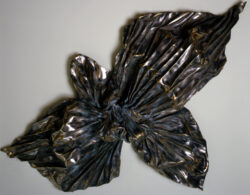Lynda Benglis
Born in Lake Charles, Lynda Benglis is an internationally renowned sculptor who is famous for her innovations in both materials and artistic process.

Courtesy of Ogden Museum of Southern Art.
Lynda Benglis' 1986 minimalist sculpture, "Minerva," measures 55 x 38 x 8 ins. and is made of bronze, nickel, and chrome.
Born in Lake Charles, Louisiana, but working out of New York City all her professional life, Lynda Benglis is an internationally renowned sculptor, famous for her innovations in materials and artistic process during the 1960s and 1970s. Her poured latex sculptures and wax paintings are seen as challenge to both the rigidity of minimalist art and the abstract expressionist drip paintings of Jackson Pollock. Throughout her career Benglis has made evocative and innovative abstract works in a variety of media, including video, latex, gold leaf, wax, glass, neon, and polyurethane foam.
Born in 1941 in Lake Charles, Louisiana, into a Greek-American family, Benglis discovered her passion for abstract expressionist art in 1960 when she saw a Franz Kline painting at the then the Isaac Delgado Museum (now the New Orleans Museum of Art). That same year she began her studies in art at Newcomb College, under the tutelage of painters Ida Kohlmeyer and Pat Trivigno, among others. Benglis earned her BFA in 1964, and moved to New York City within the same year. She briefly studied at the Brooklyn Museum of Art School, where she met artists Barnett Newman and Frank Stella.
In her early years as a painter, Benglis was deeply influenced by the individualist painterly gestures of Kline and Pollock. Seeking a way to become more physically involved in her work, in 1966 she worked on her own formula of melted purified beeswax and powdered pigments, painting onto wood in long strips not unlike the zip paintings of Newman. In 1968 she developed a method of pouring pigmented latex rubber, presenting the work on the floor as a “fallen painting.” In the early 1970s she developed her technique of making sculptures out of lava-like polyurethane foam. By the late 1970s her works shifted toward knotted metal sculptures and plaster pieces, often decorated with acrylic paint and glitter—a style of exuberance drawn from her experiences of Mardi Gras in New Orleans.
In 1974 Benglis created a well-known and controversial series of advertisements for her exhibitions at Paula Cooper Gallery in Artforum magazine. Positioned as a “call and response” to artist Robert Morris’s sexualized ads in Artforum, in the May issue Benglis presented a nude photograph of herself taken by Annie Leibovitz, followed by an ad in the November issue showing her nude. The brazenness of the image was her critique of “the art-star system” and a deliberate conflation of male and female sexuality.
In 1977 Benglis returned to the New Orleans Museum of Art to create Louisiana Prop Piece with former teacher Kohlmeyer as part of the exhibition Five From Louisiana. For this piece she installed heads and figures from Mardi Gras floats in the Great Hall. She followed this exhibition with a series of sculptures called Lagniappes, tubular forms decorated with iridescent polypropylene paper. In the following decades she continued to create sculptures in different media, ranging from gold-leafed torso-like figures to ruffled knots made of metal on mesh. Her work, which is in the collection of the New Orleans Museum of Art, operates within the complex legacy of feminist art and her Greek and Louisianan roots.
Benglis is the recipient of a Guggenheim Fellowship and two National Endowment for the Arts grants, among other commendations. She has had solo shows at The Bass Museum of Art, Miami; Kappatos Gallery, Athens, Greece; and she has been included in group shows at the Kunsthalle Wien, Austria; the Museum of Contemporary Art, Queens, New York; the Centro Internazionale Mostre, Rome; Kunsternes Hus, Oslo, Norway, and the Centre George Pompidou, Paris. Extensive public collections include the Albright-Knox Art Gallery, Buffalo, New York; the Guggenheim Museum and the Museum of Modern Art in New York City; The Los Angeles County Museum of Art; the National Gallery of Victoria in Melbourne, Australia; and the San Francisco Museum of Modern Art.
